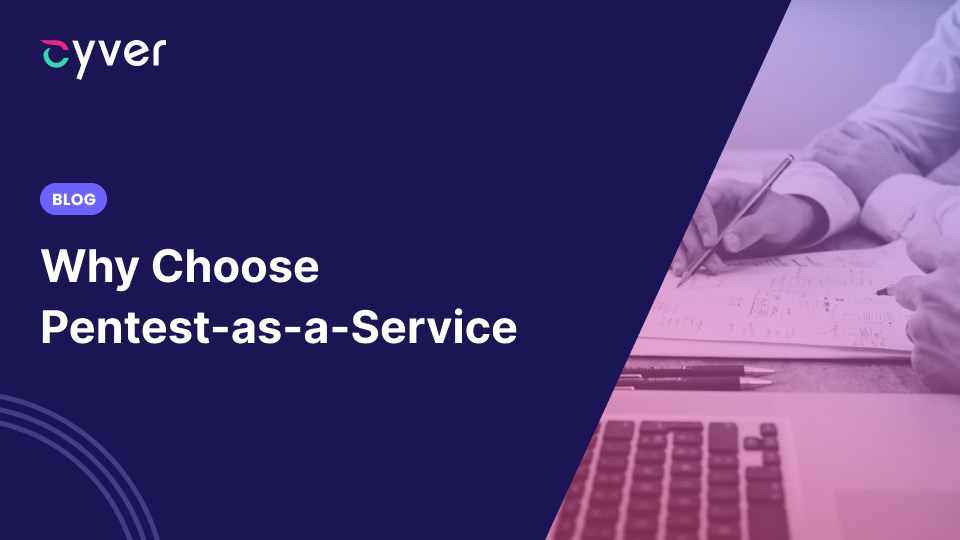Why Choose Pentest-as-a-Service
Pentest-as-a-Service is an increasingly popular pentesting model and for many organizations, it’s more popular than traditional pentesting. But, if you’re looking into switching from traditional or “one-off” pentesting and to pentest-as-a-service, it can be a big change.
What is Pentest-as-a-Service
Pentest-as-a-Service means scheduling ongoing pentesting with a single pentest firm, with pentests spread across a longer period and mapped to major development updates such as new features, major updates, or compliance needs. Here, you integrate pentesting into development and normal development, giving Dev and IT teams ownership of cybersecurity.
At Cyver, that means:
- Developers and IT directly receive vulnerability findings as tickets, in a pentest portal, so they can start remediation without waiting on a manager or third-party to process those findings
- Devs can directly communicate with pentesters to better understand the vulnerability and how to remediate it
- You can request a retest of a remediated vulnerability for free within the first 30 days of the pentest
- Pentests can be scheduled via the platform, so you can easily put impacted teams in charge of when pentests are run
- Vulnerability findings are broken down into metrics and dashboards, ideal for showing overviews to non-technical people like managers, team leads, finance people, and c-suite
- You can still generate pentest reports on-demand for compliance and management needs
That turns into multiple benefits including:
Faster Vulnerability Remediation
Cyver approach is to deliver pentest vulnerability findings as tickets, inside the pentest portal. This means that when you onboard your teams, they get notifications as vulnerability findings relevant to their features and assets are uploaded. Teams can then directly view vulnerabilities and start remediation, without waiting for the CTO or a team lead to break the report down into actionable items. Our pentest portal also allows you to export those findings directly to work management tooling like Jira.
That’s paired with metrics to help teams understand criticality ratings and to prioritize findings based on vulnerability risk – which is calculated on severity rating, how long the finding has been open, and likelihood of occurrence. That makes it easier for people who aren’t cybersecurity experts to make good decisions on prioritization.
Integrating Security into Your Teams
Cyver integrates your teams direct into pentest processes, so your teams have ownership and accountability for cybersecurity. This means that teams can:
- Request budgeted pentests of their systems using credits
- Align pentesting with their schedules
- Request and schedule lighter vulnerability assessments or code reviews earlier in the process
- Collaborate directly with pentesters to ask for help with fixes or checking that remediation worked
The idea is to shift pentesting away from being a disruptive part of development and towards being an integrated part of secure-by-design and continuous improvement development. If your people have ownership of how and when security takes place, directly see results, and can talk to the pentesters who did the work, they have much more ability to actually do the work.
In addition, the ticketing system ensures that you can assign fixes to team members or to a team, based on the related assets (features, Ip address, web app, etc.), so that the right people are responsible for the work. Cyver’s portal also makes it easier to see when fixes are remediated, for teams to mark findings as accepted risks in the system, and to enable longer-term vulnerability management.
Reducing Costs
Scheduling more pentests probably doesn’t sound more affordable. However, breaking work down into smaller pieces, ensuring that vulnerabilities are remediated, and reducing middle-men in assessments can greatly reduce costs. That’s in time spent finding a pentester, on costs for breaking down and distributing work, and on costs of getting each individual team up to speed.
In addition, pentest-as-a-service allows you to:
- Break pentests down into smaller stages, so there’s less disruption to normal work at each stage
- Schedule vulnerability assessments to catch smaller risks at each stage
- Minimize costs of research, scoping, and asset sharing – because chances are those details are the same or nearly so each time you pentest.
That will eventually enable you to greatly reduce costs over finding a new pentester each time for a one-off pentest.
In addition, with Cyver’s credit system and flat-rate pricing, you can ensure predictable pricing and costs for cybersecurity, making budgeting easier.
Everything in One Place
Cyver’s pentest portal means you have all of your pentests, vulnerability assessments, and vulnerability management in one place. It’s easy to log in to see the status of vulnerability findings from past pentests. You can also track vulnerability reoccurrence over time, giving you better insight into cybersecurity risks across your network, assets, and features. And, you can see what risks actually are with insights into critically, reoccurrence, types of risk, and time-to-fix data over time.
That’s useful for management and finance making budgeting and planning decisions but also for devs working on improvement and when checking their own work for vulnerabilities before publishing new updates.
Pentest-as-a-service shifts the focus of pentests away from compliance and reporting and towards building a secure digital organization that has the tools to be resilient to cybersecurity attacks.
If you’d like to learn more about pentest-as-a-service at Cyver, contact us to schedule a call.
